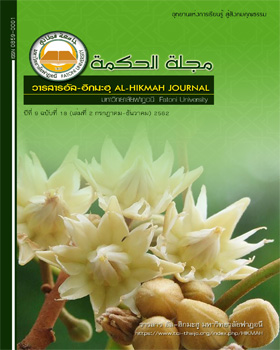ภาพแทนผู้หญิงมุสลิมกับความเหยื่อในนวนิยายเรื่อง รุสนี ของมนตรี ศรียงค์
Keywords:
ภาพแทน, เหยื่อ, ผู้หญิงมุสลิม,วรรณกรรมAbstract
Abstract
This study entitled “The Representation of Muslim Women and Victimization in the Novel of Rusnee Written by Montri Sriyong”, which was produced after the violent events in the southernmost provinces in the period of 2004, aims to investigate the representation of Muslim women and victimization. The findings show that the representation can be divided into two points: the Muslim women and victims of the situational unrest and the Muslim women and victims of the sexual violence. The representation of Muslim women presented through the novel is the image of women assaulted by the violence causing them to be the victims of both situational violence and sexual abuse being assaulted by men both insiders and outsiders. As a result, the representation of the Muslim women portrays loss, weakness, sadness, depression, aimlessness and need to be protected by the men bringing them going through those tough situations.
The representation of Muslim women shaped by Montri Sriyong, who was a Buddhist author, reveals that it is to extend understanding towards situational violence in the southernmost provinces and attempt to adapt outsiders’ attitudes to the people in the area acquiring news and information of the continuous unrest situation for ages. This leads to a stereotypes of the outsiders that all people in the area get involved with the terrorists resulting in the stereotype of negative mindsets of hatred towards Muslims and discrimination in Thai society. The author of this novel selected females as the characters presenting violence in the area that affects both Muslims and Buddhists being victimized inevitably.
References
กนกพงศ์ สงสมพันธุ์. 2539. แผ่นดินอื่น. ปทุมธานี: นาคร.
จรรยา อำนาจพันธุ์พงศ์. 2554. ความเงียบของลัยลา. กรุงเทพฯ: แพรวสำนักพิมพ์.
ชัยวัฒน์ สถาอานันท์. 2551. ความรุนแรงกับการจัดการ “ความจริง” ปัตตานีในรอบกึ่งศตวรรษ. กรุงเทพฯ: สำนักพิมพ์มหาวิทยาลัยธรรมศาสตร์.
ณ เสนา อรุโณทัย, นามแฝง. 2553. มากกว่ารัก...วีรบุรุษยะลา. กรุงเทพฯ: แอนีเมท กรุ๊ป.
ปริญญา นวลเปียน. 2551. นอกนิยามความเป็นไทย. สงขลา. ศูนย์ทะเลสาบศึกษา.
พิเชฐ แสงทอง. 2550. วาทกรรมวรรณกรรมเปิดกระบวนทัศน์ใหม่ ในการศึกษาวรรณกรรมไทยร่วมสมัย. มหาสารคาม: มหาวิทยาลัยมหาสารคาม.
แพร ศิริศักดิ์ดำเกิง. 2551. องค์ความรู้เกี่ยวกับจังหวัดชายแดนภาคใต้ ท่ามกลางสถานการณ์ความรุนแรง
(พ.ศ. 2547 – 2550) โครงการศึกษาพัฒนาชุมชนโดยชุมชน ศูนย์ศึกษาและพัฒนาสันติวิธี (รายงานผลการวิจัย) . กรุงเทพฯ: มหาวิทยาลัยมหิดล.
ไพฑูรย์ ธัญญา. 2539. ตุลาคม. ปทุมธานี: นาคร.
มนัส จรรยงค์. 2550. บาโหย. ใน พิเชฐ แสงทอง (บรรณาธิการ), แขกในบ้านตัวเอง. ปทุมธานี: นาคร.
มนตรี ศรียงค์. 2555. รุสนี. กรุงเทพฯ. สามัญชน.
วิน วนาดร. 2550. มาตุภูมิเดียวกัน. กรุงเทพฯ: มติชน.
สุชีพ ณ สงขลา. 2522. ซือโก๊ะ แซกอ. กรุงเทพฯ: สำนักพิมพ์สิโก.
สำนักงานคณะกรรมการพัฒนาเศรษฐกิจและสังคมแห่งชาติ. 2552. แผนพัฒนาพื้นที่พิเศษ 5 จังหวัดชายแดนภาคใต้. สืบค้นจาก https://www. Slbkb.psu.ac.th
อิราวดี ไตลังคะ. 2546. ศาสตร์และศิลป์แห่งการเล่าเรื่อง. กรุงเทพฯ. มหาวิทยาลัยเกษตรศาสตร์.
Hall, Suart. 1997. Representation : Cultural representations and signifying practices. London. Sage.



